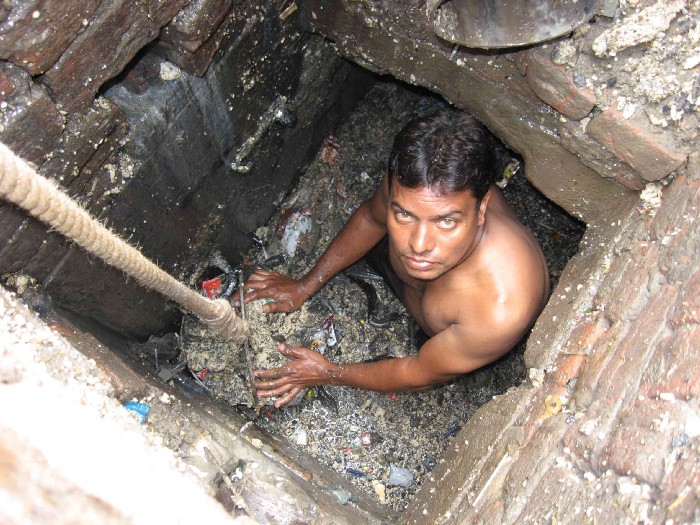By Asees Kaur


Manual scavenging is an inhumane practice that involves the removal of human excreta from dry latrines, open drains and sewers using bare hands or brooms. Historically, it was members of the lower castes that were forced into performing these menial jobs. While this is a hazardous job that strikes at the dignity of an individual, the government only banned this practice in 1993.
Even after the employment ban in 1993 and a prohibitory legislation in 2013, workers continue to be employed as manual scavengers. The laws passed by the government make it an offence to employ manual scavengers and also facilitate their rehabilitation. However, approximately 12 lakh scavengers are still present and employed in the country.
Who are manual scavengers ?
A manual scavenger is any person that is engaged in manually cleaning undecomposed human excreta from open drains, insanitary latrines, pits, railway tracks. This could be undertaken on a contractual or a regular basis and could be employed by any person. The law however excludes those doing this work while wearing appropriate protective gear.
What is the appropriate protective gear ?
If a person is employed to clean a sewer or a septic tank, they must be provided with protective gear by their employer. Amongst other things, these safety devices include chlorine masks, emergency medical oxygen resuscitator kit, full body wader suit, safety goggles and helmets. It is also the duty of the local authority to ensure that cleaning devices such as Deep Suction Combined Machines, Hydraulic Operated Trolley Mounted Grab Bucket, hoses and other washing instruments are provided to individuals cleaning sewers.
In addition to this, comfortable bodysuits must be provided to the workers who have to enter sewers or septic tanks for their cleaning. All protective gear and safety devices must also be checked every six months and necessary repair or replacements need to be made by the employers, if necessary.
What are the health risks involved in manual scavenging?
Manual scavengers are exposed to various gases as a result of their work. These include hydrogen disulfide, carbon (IV) oxide, ammonia, and methane. Increased exposure to these gases can result in visual impairment, respiratory problems and even seizures. These workers are also at risk of death by asphyxiation which occurs as a result of the gas, hydrogen disulfide, present in the sewers. The manholes and septic tanks, where the manual scavengers are forced to work in, are home to numerous bacteria that cause infections such as Leptospirosis. Manual Scavengers are at an increased risk of getting this since sewers are often home to animal and rodent excreta.
Owing to poor regulations there is no concrete data on the true extent of the employment of manual scavengers. In light of this, it is disheartening to know that one manual scavenger dies every five days. These individuals do not get access to healthcare services due to their caste status and during the course of such work they are more susceptible to dying. Rehabilitation under the Prohibition of Employment of Manual Scavengers and their Rehabilitation Act, 2013 also fails as it does not take into account the inherent health hazard of this occupation.
What is punishable under the law against manual scavenging ?
- Employing a manual scavenger
Under the act, employing a manual scavenger or a person for hazardous cleaning of a sewer without any protective gear is considered illegal.
2. Building an insanitary latrine
It is unlawful for anyone to build an insanitary latrine which requires a manual scavenger to remove the human excreta that has not been decomposed.
3. Owning an insanitary latrine
If an individual occupies a property with an insanitary latrine then they are required to convert it into a sanitary latrine or demolish it.
Is manual cleaning of sewers ever allowed ?
No, manual cleaning of sewers or septic tank even with protective gear and safety devices is not allowed. However, the law provides for exceptions under Section 3 of The Prohibition of Employment as Manual Scavengers and their Rehabilitation Rules, 2013. These include situations where manhole doors are damaged and thus mechanical equipment cannot be put into operation. If it is absolutely necessary to have manual sewage cleaning, then this must be informed to the Chief Executive Officer (CEO) of the local authority who might permit it after recording the reasons in writing.
Identification of Manual Scavengers and their Rehabilitation
If any municipality or panchayat has a reason to believe that some people are engaged or employed in manual scavenging within its jurisdiction, the CEO of such a Municipality or Panchayat is required to conduct a survey to identify such persons. After completion of the survey, the final list of manual scavengers is published and the persons mentioned in this list will be discharged from any obligation to work as manual scavengers. Either during or after such a survey is conducted, any person working as a manual scavenger can either apply to the CEO for being identified as a manual scavenger. The CEO conducts an enquiry to ascertain whether the applicant is a manual scavenger and can be added to the list and rehabilitated.
Once it is confirmed that a person is working as a manual scavenger, they can receive the benefits of rehabilitation under the law.
Manual Scavengers and Discrimination
The task of manual scavenging has always been linked to lower castes, where it is believed that is their job to manage the waste of the upper castes. Members of the Dalit community in India have been discriminated against for years. Therefore, it is hard to disclose the identity of manual scavengers because of the way in which they will be treated. Scavengers who perform this work as well as their family members are often called casteist slurs such as “bhangi” or “chamar”. Since majority of the manual scavengers are women, discrimination is aggravated on the basis of their gender too. These women are also not allowed to change their job and are subjected to violence. Women are also less likely to be taken to the hospital if they are sick as they are viewed as a burden on the household. The need of the hour is to view manual scavenging not just as a sanitation problem but as a caste and gender issue.
Do we really have a Swachh Bharat ?
According to the Urban Development Ministry, the Swachh Bharat Mission resulted in the building of 50 lakh household toilets . However, most of the toilets are single pit toilets that need to be manually cleaned after a year of using them. The question then remains, who cleans these toilets? Unfortunately, it is these manual scavengers that are forced into cleaning these toilets since there is no proper waste management system. Therefore, along with building more toilets it is necessary that toilets are connected with a sewage system that involves mechanised waste disposal. While the country develops and moves towards a more sanitary society, the scavengers do not receive the benefits of this development.
Recommendations
Despite the prohibitory ban on employment as manual scavengers and the ban on construction of insanitary latrines under the 2013 Act, the practice continues to take place but the numbers are underreported by the ministries.
In light of this, there is a need for organizing awareness camps in each and every district of the country about the laws against manual scavenging. The Indian Railways should also ensure that cleaning work on the passenger coaches be mechanized to the maximum extent possible. They should also stop manufacturing new coaches that have direct discharge toilets. As far as possible, the cleaning of sewers and manholes should be mechanized and human intervention for such work should be kept to the minimum to prevent sewer deaths.
Millions of people in India are still unable to come out from the trap of their caste that forces them into this practice of manual scavenging. The police also do not register cases of these crimes as its most often Dalits making complaints against upper castes. The casual attitude of the state in addressing this problem has resulted in the administration not removing insanitary latrines that are the root cause of this problem. The Ministry of Social Justice and Empowerment has drafted a proposal for a better implementation of the Act and we hope that these recommendations are put into practice.
__________________
Asees Kaur is a student at West Bengal National University of Juridical Sciences and a member of Kautilya Society, an initiative of Vidhi Centre for Legal Policy. Views are personal


